国际海运危险货物规则中英文版本介绍
- 格式:doc
- 大小:30.50 KB
- 文档页数:2
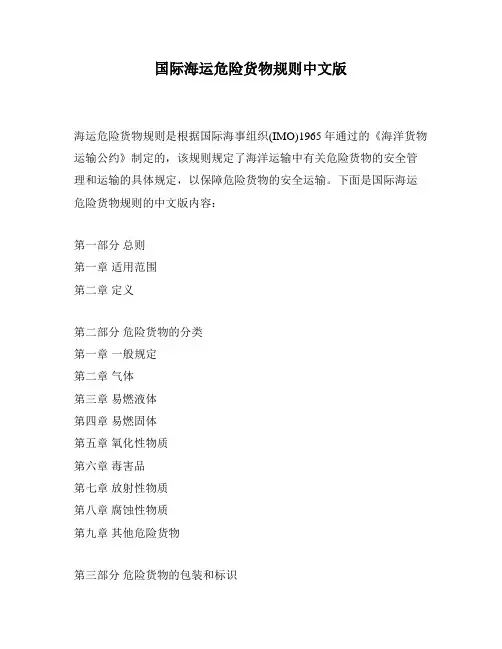
国际海运危险货物规则中文版
海运危险货物规则是根据国际海事组织(IMO)1965年通过的《海洋货物运输公约》制定的,该规则规定了海洋运输中有关危险货物的安全管理和运输的具体规定,以保障危险货物的安全运输。
下面是国际海运危险货物规则的中文版内容:
第一部分总则
第一章适用范围
第二章定义
第二部分危险货物的分类
第一章一般规定
第二章气体
第三章易燃液体
第四章易燃固体
第五章氧化性物质
第六章毒害品
第七章放射性物质
第八章腐蚀性物质
第九章其他危险货物
第三部分危险货物的包装和标识
第一章包装
第二章标识
第三章标签和标牌
第四章运输文件和证明文件
第四部分危险货物的装载和卸载
第一章一般规定
第二章装载和卸载的要求
第三章货舱、罐舱和集装箱的清洁
第四章货物的分隔和隔离
第五部分运输、装卸危险货物的运输工具的要求第一章运输工具的分类
第二章散货船的要求
第三章油罐船的要求
第四章化学品船的要求
第五章集装箱船的要求
第六章运输车辆和铁路运输的要求
第六部分危险货物的运输和应急预案
第一章运输的一般要求
第二章运输工具的要求
第三章应急预案的要求
第七部分培训和监管
第一章培训
第二章监管和执法
总结:国际海运危险货物规则的中文版内容共分为七部分,详细规定了危险货物的分类、包装和标识、装载和卸载、运输工具的要求、运输和应急预案、培训和监管等方面的内容。
这些规定为保障危险货物在海洋运输中的安全提供了有力的保障。

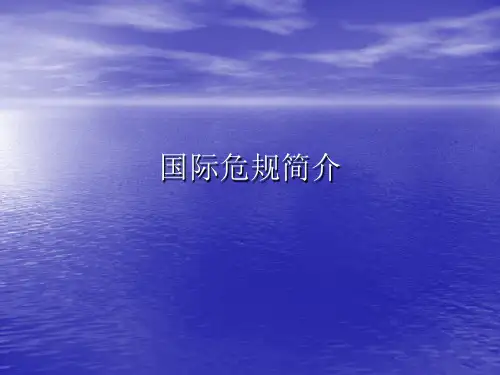
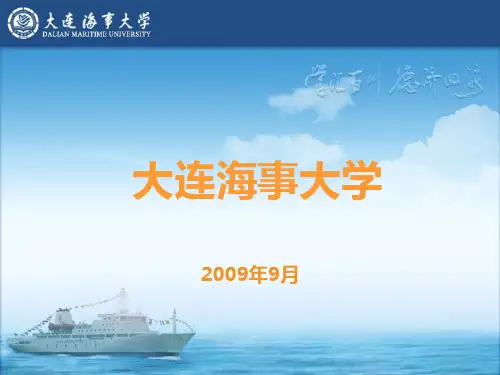
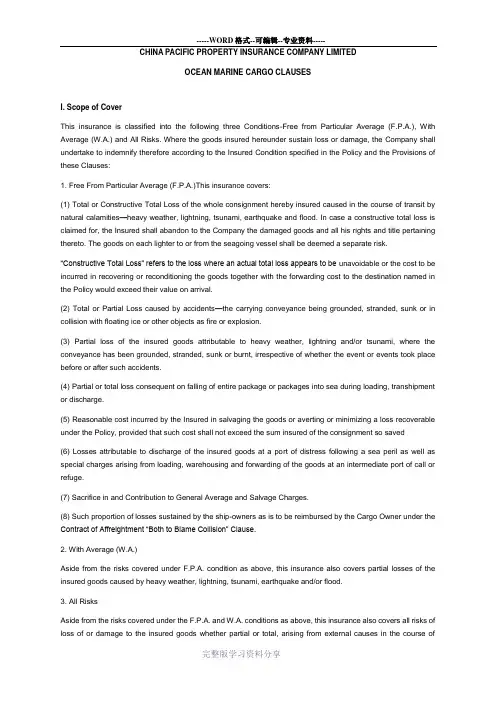
CHINA PACIFIC PROPERTY INSURANCE COMPANY LIMITEDOCEAN MARINE CARGO CLAUSESI. Scope of CoverThis insurance is classified into the following three Conditions-Free from Particular Average (F.P.A.), With Average (W.A.) and All Risks. Where the goods insured hereunder sustain loss or damage, the Company shall undertake to indemnify therefore according to the Insured Condition specified in the Policy and the Provisions of these Clauses:1. Free From Particular Average (F.P.A.)This insurance covers:(1) Total or Constructive Total Loss of the whole consignment hereby insured caused in the course of transit by natural calamities—heavy weather, lightning, tsunami, earthquake and flood. In case a constructive total loss is claimed for, the Insured shall abandon to the Company the damaged goods and all his rights and title pertaining thereto. The goods on each lighter to or from the seagoing vessel shall be deemed a separate risk.“Constructive Total Loss” refers to the loss where an actual total loss appears to be unavoidable or the cost to be incurred in recovering or reconditioning the goods together with the forwarding cost to the destination named in the Policy would exceed their value on arrival.(2) Total or Partial Loss caused by accidents—the carrying conveyance being grounded, stranded, sunk or in collision with floating ice or other objects as fire or explosion.(3) Partial loss of the insured goods attributable to heavy weather, lightning and/or tsunami, where the conveyance has been grounded, stranded, sunk or burnt, irrespective of whether the event or events took place before or after such accidents.(4) Partial or total loss consequent on falling of entire package or packages into sea during loading, transhipment or discharge.(5) Reasonable cost incurred by the Insured in salvaging the goods or averting or minimizing a loss recoverable under the Policy, provided that such cost shall not exceed the sum insured of the consignment so saved(6) Losses attributable to discharge of the insured goods at a port of distress following a sea peril as well as special charges arising from loading, warehousing and forwarding of the goods at an intermediate port of call or refuge.(7) Sacrifice in and Contribution to General Average and Salvage Charges.(8) Such proportion of losses sustained by the ship-owners as is to be reimbursed by the Cargo Owner under the Contract of Affreightment “Both to Blame Collision” Clause.2. With Average (W.A.)Aside from the risks covered under F.P.A. condition as above, this insurance also covers partial losses of the insured goods caused by heavy weather, lightning, tsunami, earthquake and/or flood.3. All RisksAside from the risks covered under the F.P.A. and W.A. conditions as above, this insurance also covers all risks of loss of or damage to the insured goods whether partial or total, arising from external causes in the course oftransit.II. ExclusionsThis insurance does not cover:1、Loss or damage caused by the intentional act or fault of the Insured.2、Loss or damage falling under the liability of the consignor.3、Loss or damage arising from the inferior quality or shortage of the insured goods prior to the attachment of this insurance.4、Loss or damage arising from normal loss, inherent vice or nature of the insured goods, loss of market and/or delay in transit and any expenses arising therefrom.5、Risks and liabilities covered and excluded by the Ocean Marine Cargo War Risks Clauses and Strike, Riot and Civil Commotion Clauses of this Company.III. Commencement and Termination of Cover1、Warehouse to Warehouse Clause:This insurance attaches from the time the goods hereby insured leave the warehouse or place of storage named in the Policy for the commencement of the transit and continues in force in the ordinary course of transit including sea, land and inland waterway transits and transit in lighter until the insured goods are delivered to the consignee’s final warehouse or place o f storage at the destination named in the Policy or to any other place used by the Insured for allocation or distribution of the goods or for storage other than in the ordinary course of transit. This insurance shall, however, be limited to sixty (60) days after completion of discharge of the insured goods from the seagoing vessel at the final port of discharge before they reach the above mentioned warehouse or place of storage. If prior to the expiry of the above mentioned sixty (60) days, the insured goods are to be forwarded to a destination other than that named in the Policy, this insurance shall terminate at the commencement of such transit.2、If owing to delay, deviation, forced discharge, reshipment or transhipment beyond the control of the Insured or any change or termination of the voyage arising from the exercise of a liberty granted to the ship-owners under the contract of affreightment, the insured goods arrive at a port or place other than that named in the Policy, subject to immediate notice being given to the Company by the Insured and an additional premium being paid, if required, this insurance shall remain in force and shall terminate as hereunder:(1)If the insured goods are sold at port or place not named in the Policy, this insurance shall terminate on delivery of the goods sold, but in no event shall this insurance extend beyond sixty (60) days after completion of discharge of the insured goods from the carrying vessel at such port or place.(2)If the insured goods are to be forwarded to the final destination named in the Policy or any other destination, this insurance shall terminate in accordance with Section 1 above.IV. Duty of the InsuredIt is the duty of the Insured to attend to all matters as specified hereunder:1、The Insured shall take delivery of the insured goods in good time upon their arrival at the port of destination named in the Policy. In the event of any damage to the goods, the Insured shall immediately apply for survey to the survey and /or settling agent stipulated in the Policy. If the insured goods are found short in entire package orpackages or to show apparent traces of damage, the Insured shall obtain from the carrier, bailee or other relevant authorities (Customs and Port Authorities etc.) certificate of loss or damage and /or shortlanded memo. Should the carrier, bailee or the other relevant authorities be responsible for such shortage or damage, the Insured shall lodge a claim with them in writing and, if necessary, obtain their confirmation of an extension of the time limit of validity of such claim. If the Insured fails to fulfill the aforesaid obligations, the Insurer shall not be liable for the indemnity to the loss or damage attributable to such failure.2、The Insured shall, and the Company may also, take reasonable measures immediately in salvaging the goods or preventing or minimizing a loss or damage thereto. The measures so taken by the Insured or by the Company shall not be considered respectively, as a waiver of abandonment hereunder, or as an acceptance thereof.The Insurer shall not be liable for the indemnity to the increased loss or damage attributable to the Insured’s failure to fulfill the aforesaid obligations.3、In case of a change of voyage or any omission or error in the description of the interest, the name of the vessel or voyage, this insurance shall remain in force only upon prompt notice to this Company when the Insured becomes aware of the same and payment of an additional premium if required.4、The following documents should accompany any claim hereunder made against this Company:Original Policy, Bill of Lading, Invoice, Packing List, Tally Sheet, Weight Memo, Certificate of Loss or Damage and/or Shortlanded Memo, Survey Report, Statement of Claim.If any third party is involved, documents relative to pursuing of recovery from such party should also be included.If the Insured fails to provide the aforesaid claim documents, the Insurer shall not be liable for the indemnity tothe parts of the loss or damage which can not be verified due to such failure.5、Immediate notice should be given to the Company when the Cargo Owner’s actual responsibility under the contract of affreightment “Both to Blame Collision ” Clause becomes known. Otherwise, the Insurer shall not be liable for the indemnity to the loss or damage attributable to such failure.Ⅴ. Claims HandlingThe Insurer shall upon receipt of a claim from the Insured, check and ascertain without delay whether this insurance covers the loss or damage ,then notify the Insured of the result. Where in the circumstances of complicated claim the Insurer fails to ascertain the facts within thirty days after receiving the claim and the relevant documents from the Insured, the Insurer shall discuss and agree on a reasonable claim handling period with the Insured according to the actual situation. Then the Insurer shall ascertain the facts and notify the insured of the result within this period. Where the loss or damage is covered by the insurance, the Insurer shall fulfil the obligation of indemnity to settle the claim within ten days from reaching an agreement on the amount of indemnity with the Insured.Ⅵ. The Time of Validity of a ClaimThe time of validity of a claim under this insurance shall not exceed a period of two years counting from the day on which the peril insured against occurred.。
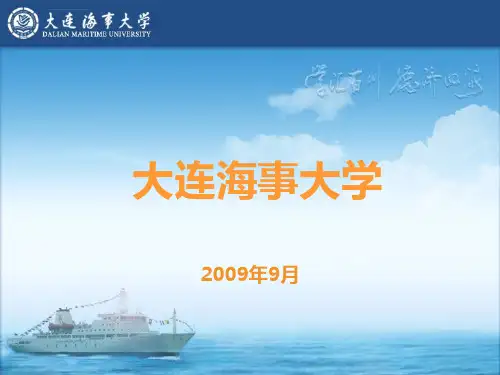
![1国际海运危险货物规则IMDG Code[1]](https://uimg.taocdn.com/e44e8a41a300a6c30c229f81.webp)
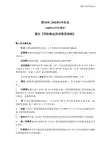
第MSC.268(85)号决议(2008年12月4日通过)通过《国际海运固体散货规则》海上安全委员会,忆及《国际海事组织公约》关于本委员会职能的第28(b)条,注意到本委员会通过了关于《2004年固体散货安全操作规则》的第MSC.193(79)号决议,认识到强制适用统一的海运固体散货国际标准的需要,还注意到本委员会以第MSC.269(85)号决议通过的经修正的《1974年海上人命安全公约》(下文称《公约》)第VI和VII章修正案,以使《国际海运固体散货规则》依据《公约》成为强制性规则。
在其第85届会议上审议了建议的《国际海运固体散货规则》文本,1. 通过《国际海运固体散货规则》(《固体散货规则》),其文本载于本决议的附件中;2. 注意到根据上述《公约》第VI章的修正案,《固体散货规则》将来的修正案须按照有关《公约》附则除第I章外的适用修正案程序的《公约》第VIII条规定予以通过、实施和生效,3. 请《公约》缔约国政府注意,一旦《公约》第VI和VII章的修正案生效,《固体散货规则》将于2011年1月1日生效;4. 同意《公约》缔约国政府在自愿的基础上自2009年1月1日起全部或部分实施《固体散货规则》;5. 要求秘书长向《公约》所有缔约国政府送发本决议及其附件的核证无误副本;6. 进一步要求秘书长向所有非《公约》缔约国政府的本组织会员国送发本决议及其附件;7. 注意到附件中的《固体散货规则》取代以第MSC.193(79)号决议通过的《2004年固体散货安全实用规则》。
ANNEX 3Page 2附件《国际海运固体散货规则》目 录前言第1节一般规定第2节一般装载、装运和卸载预防措施第3节人员与船舶安全第4节评定货物的安全适运性第5节平舱程序第6节确定静止角的方法第7节易流态化货物第8节易流态化货物的测试程序第9节具有化学危险的货物第10节固体散装废物运输第11节保安规定第12节积载因数换算表第13节相关信息和建议的参考资料附录1 各固体散装货物明细表附录2 实验室测试程序、使用的仪器和标准附录3 固体散物的特性附录4 索引物外,当时不可能形成详细要求。
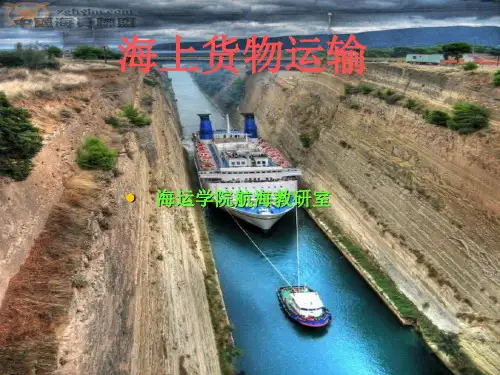
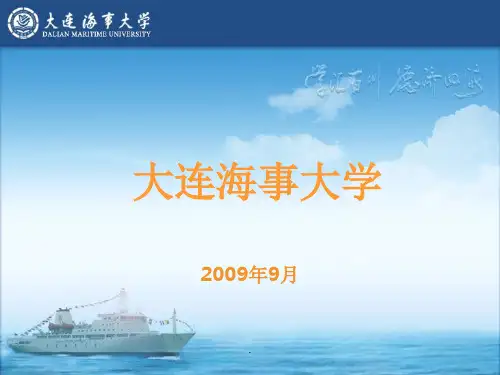
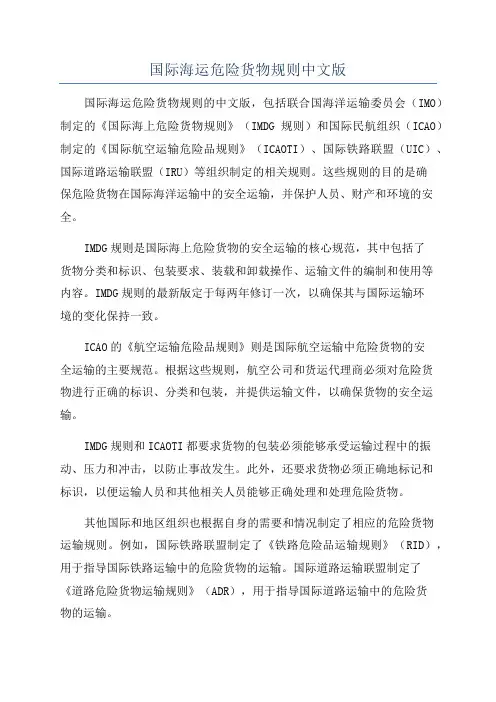
国际海运危险货物规则中文版国际海运危险货物规则的中文版,包括联合国海洋运输委员会(IMO)制定的《国际海上危险货物规则》(IMDG规则)和国际民航组织(ICAO)制定的《国际航空运输危险品规则》(ICAOTI)、国际铁路联盟(UIC)、国际道路运输联盟(IRU)等组织制定的相关规则。
这些规则的目的是确保危险货物在国际海洋运输中的安全运输,并保护人员、财产和环境的安全。
IMDG规则是国际海上危险货物的安全运输的核心规范,其中包括了货物分类和标识、包装要求、装载和卸载操作、运输文件的编制和使用等内容。
IMDG规则的最新版定于每两年修订一次,以确保其与国际运输环境的变化保持一致。
ICAO的《航空运输危险品规则》则是国际航空运输中危险货物的安全运输的主要规范。
根据这些规则,航空公司和货运代理商必须对危险货物进行正确的标识、分类和包装,并提供运输文件,以确保货物的安全运输。
IMDG规则和ICAOTI都要求货物的包装必须能够承受运输过程中的振动、压力和冲击,以防止事故发生。
此外,还要求货物必须正确地标记和标识,以便运输人员和其他相关人员能够正确处理和处理危险货物。
其他国际和地区组织也根据自身的需要和情况制定了相应的危险货物运输规则。
例如,国际铁路联盟制定了《铁路危险品运输规则》(RID),用于指导国际铁路运输中的危险货物的运输。
国际道路运输联盟制定了《道路危险货物运输规则》(ADR),用于指导国际道路运输中的危险货物的运输。
综上所述,国际海运危险货物规则的中文版包括了IMDG规则、ICAOTI、RID、ADR等相关规则,这些规则旨在确保危险货物能够安全运输,保护人员、财产和环境的安全。
危险品货物DANGEROUS GOODSWHAT ARE THEY? 什么是危险品Dangerous goods are substances that are potentially hazardous for health, safety or the environment. In order to minimize risks associated with their transportation, dangerous goods are required to comply with some special conditions for their handling, loading or labeling.危险品是对健康、安全或环境有潜在危险的物质。
为了最大限度地减少与运输有关的风险,危险货物在处理、装载或贴标签时必须遵守一些特殊条件。
International legislation国际法规Due to their singularity and the specific requirements, dangerous goods’ transportation is subject to a strict international regulation in every transport modality.由于其特殊性和具体要求,危险品的运输在每一种运输方式中都受到严格的国际监管。
They are classified in five categories它们被分为五个类别:∙European Agreement concerning the International Carriage of Dangerous Goods by Road (ADR)欧洲国际公路运输危险货物协定(ADR):Signed in 1957 in Geneva by the United Nations, it currently includes 51 countries.The agreement regulates the terms of dangerous goods’ road carriage.该协议由联合国于1957年在日内瓦签署,目前包括51个国家。
【doc】如何使用新版《国际海运危险货物规则》如何使用新版《国际海运危险货物规则》如何使用新版《国际海运危险货物规则》青岛远洋船员学院张晓[内容提要]根据IMO(国际海运危险货物规则》第30次修正案修正的中文版《国际海运危险货物规则》业已正式出版发行.此文通过介绍新版《国际海运危险货物规则》的使用方法,附带介龆其与旧版比较有那些王要变化关键词:新版《国际危规》第30套《国际危规》使用方法H0wtoUesNewEditionIMDGCode 根据IMO{国际海运危险货物规则》第30次修正案修正的2000年版《国际海运危险货物规则)(以下称第30套《国际危规)或新版《国际危规)),其中文版已于2001年11月正式出版发行经过改版的第30套《国际危规》将以前的每套5 册改为3册.第一册包括七个部分,第一部分:总则,定义和培训;第二部分:分类;笫三部分:危险货物一览表和限虽内免除(主要内容放在第二册);第四部分:包装和罐柜规定;第五部分:托运程序;第六部分:容器,中型散装容器,太宗包装;第七部分:运输作业的有关规定.第二册的主要内容为危险货物一览表以及危险货物的英,中文名称索;f.新版《斟际危规》补充本删包括应急措施,医疗急救指南,报告程序,货物运输组件的装载,船舶安全使用杀虫剂,INF规则及附录等内容. 从使用的角度来看,作为船舶驾驶和管理人员,平时接触和使用最多的应是新版《围际危规)的第二册和补充本.I新版《国际危规》第二册的使用新版《国际危规》第二册的主要内容为危险货物一览表,这部分内容为新版《国际危规)最大改动之处.首先,在新版《国际危规)危险货物一览表中,取消r总索引.由于采用新的编排方式,将原来分散在三册上的危险货物的细资料紧缩到一册上,这就大大方便了有关危险货物详细资料的查找.如果我们知道某种要查询的苊险货物的联合国编号,则可以直接翻查新版《国际危规》第二册危险物一览表,因为该苊险货物一览表中的危险货物是按联合国编号顺序排列的,所以查找起来很方便(注:旧版《国际危规》中的危险货物是按其危险类别来排的,因此无序,故必须用总索引查找)如果我们只知道某种危险货物的正确运输名称.则首先应在薪版《国际危规》第二册的危险货物英文和中文名称索引中查该苊险货物的联合国编号,再根据该联合国编号查危险货物一览表,以获取该危险货物的详细资料.危险货物英文或中文名称索引是按英文字母顺序或中文挣:音字母顺序排列的,由于有规律,查找并不困难.在新版《国际危规》第二册危险货物一鉴表中提供 lr3363种列明联合国编号的危险货物的正确运输名称,及这些危险货物的类别,副危险,包装类,特殊规定,限量,包装,Em$表号,积载与隔离要求,特性及注意事项等资料.新版《国际危规》较之旧版《国际危规>,在危险货物一览表中增加j,特殊规定,限量,中型散装容器(IBC)包装导则,中型散装容器特殊规定,IMO罐柜导则,U罐柜导则和罐柜特殊规定,另外将EmS 表号也放到了一览表中,但取消了危险货物分子式这一内容2233培训要点从事准备交付海上危险货物运输的岸方人员应接受与其职责丰[1匹配的有关危险货物规定内容的培训. I)总体了解/熟悉培训:A每人都应接受旨在使其熟悉危险货物运输一般规定的培训;I3此类培训应包括:各类危险货物的特征,标志, 标记,标牌,包装,税载,隔离和配装类规定;对危险货物运墒单证目的和内容的描述(多式联运危险货物申报表和集装箱/车辆包装证明);对适用的应急反应文件的描述.2)具体职责培圳:每人都应接收有关部门关于危险货物运输规定的,通用于该受训人所履行职责的详细培训.3)安全培训:鉴于发生事故时暴露的危险及直履行的职责,每人都应接受下列方面的培训: A预防事故的方法或措施,包件装卸设备的合理使用和危险货物积载的正确方式;B可得到的应急反应资车耳以及如何使用: C各兴危险货物呈现的危险及在暴露时如何防止这些危险.如何使用个人防护服和防护设备: D危险货物偶然事故发生之后应立即采取的措施,包括由该人负责的任何应急反应措施和应采取的个人防护措施.223.4初期培训和再培训1)初期培训:对应从事的岗位和上述内容确定. 2)再培训:主管机关认为适当时进行再培训及确定再培训内容.(待续)(航簿技术)2002年第3崩下面举例说明新版<国际危规》第二册危险货物一览表的使用和查找方法.以聪合国编号为1230的危险货物为例,经查新版《国际危规》危险货物一览表知:该危险货物的正确运输名称为甲醇:危险类别为3类;副危险类别为6.1类:包装类别为】】:特蛛规定为279;限量为1I;包装为P001;中型散装容器包装导则为IB('02:IMo罐柜导则为T4;UN罐柜导则为T7;罐柜特殊规定为TT2:Eros表号为3一O6.积载娄为I类; 特胜及注意事项为无色,挥发性液体,闪点C,爆炸极限6t,365%.与水混溶.吞咽会中毒.引起眼睛失明,避免皮肤接触在上述资料中,危险类别,副危险类别,包装类,限量,积载类,特性及注意事项等,只要掌握普通的货运知识,便可理船其含义:而特殊规定,包装,中型散装容器包装导则,IM0罐柜导则,UN 罐柜导则,罐柜特赇规定,Ems表号等,其对直字母或数字代码的古义还需要查阅新版《国际危规》的其它章节才能得知本例中:"特殊规定"的数字代码含义血查新版《国际危规》第?册第33章;"包装"的字母代码的含义应奇新版《际危规》第一册第4.14节:EmS 表号所对应的EmS表应查新版《吲际危规》补充l率一如果甲醇是装在巾型散装容器或罐柜内,就需要根据中型散装容器包装导则,1MO 罐柜导则,UN罐柜导则, 罐衔特殊规定等埘应的字母代码,在新版《国际危规》第一册中查找这些字母代码的含义.如果装运的是放射性物质.可直接到新版《国际危规》第二册放射性物质的运输明细表中查找该种危险货物的详细资料,冈为危险货物一览表中已不能包含运输放射性物质所需要的全部信息.放射性物质的运输明细表中一共列明r14种放射性物质的运输信息, 这14种放射性物质电是按联合国编号顺序排列的.查找很方便.由于危险货物一览表中不可能列出所有的危险货物名称.此.许多危险货物只能在通用的或未另列明的条目下运输.新板《际危规》第一册给出了通用的和未另列明条H的正确运输名称的清.凡是运输该清单上已知联台国编号的危险货物(在危险货物一览发中该货物的正确运墒名称有"未另列明的"字样, 或该表第6内的数字代码为"274"),就有嘶个需要注意的:一是必须在确定它危险特性后方可运输:一是其王确运输名称城技术名称加以补充 2新版《国际危规》补充本的使用新版《国际危趣》补克本和lH版《国际危规》补充本所包括的主要1客相同,新版《际危规》补充本将 "J急措施袭(HmS)"和"医疗急救指南(MFAG)"这两部分内弈的位置予提前.放到r补充本的最前面,这阿部分内容其实也足《国际危规》补充本中必须学会使用的两千内容在使用"应急措施表"时需注意,第30套《国际危规)中的"应急措施表"目前仍采用旧版资料,新版"应急措施表"将在第31套(2002年版)<国际危规)中推出.根据新版《国际危规》第二册危险货物一览表中给出的某种危险货物相应的EmS表号,可以在"应急措施表"中查取该种危险货物在运输时需配备的专用应急器材,在处理事故前应急队应做的准备工作,具体应急行动以及有关医疗急救方面的提示等信息. 新版《国际危规》补充本中的"医疗急救指南和旧版相比较有,很大的变化旧版《国际危规》中有 MFAGj蔓,可根据总索引中某种危险货物对应的 MFAC-表号,查取一旦由于危险货物事故,需要对人员进行医疗急救,应采取哪些具体的医疗急救措施.新版《国际危规》取消了MFAG 表,取而代之的是在进行紧急抢救和诊断时用的问题表和20个"表"及】5个 "附录".新版《国际危规》朴充本中的"医疗急救指南" 要求,在使用该"指南"时应分三步走:第一步是紧急抢救和诊断.在进行紧急抢救和诊断时,先顺序回答紧急抢救和诊断问题表巾的提问,并根据提示参见有关的 "表"和"附录".例如,在回答紧急抢救阿题表中的提问 "伤员不肯人事吗?",如果回答"是",则根据提示"参见表4";在回答诊断问题表中的提问"伤员现在处于昏迷状态吗?",如果回答"是".则根据提示"参见表4和附录4"第二步是查"表"."医疗急救指南"中有20个 "表",分别给出各种特殊情况处理的简要指导,如对 "抢救","心肺复苏","输氧与控制通风","化学品引起的意识障碍","化学品引起的惊厥","中毒性精神错乱","眼睛接触化学品","皮肤接触化学品","吸人化学品","休克"等特殊情况处理的简要指导.救治者可根据紧急抢救和诊断问题表中绐出的提示查相应的 "表",以获取相应的医疗急救建议和指导.第三步是查 "附录""医疗急救指南中有15个"附录",分别提供了各种特殊情况处理的详细指导,以及药品和设备清单,物质清单等.同样,救治者可根据诊断问题表中给出的提示查相应的"附录",获取更为详细的建议和指导以对新版《国际危规》第一册和补充本的,些基本使用方法作了简要介绍.当然,从事与危险货物海上运输有关同志,还应掌握新版《国际危规》第一册的使用方法.特别是对于第一册中的第二部分(分类)和第七部分(运输作业的有关规定),不仅仅要学会查找这 l而部分中的有关内容,还要通过平时的学习,掌握这两部分中的一些基本知识.只有这样才能真正用好新版《国际危规》.Nf,,J使用新版(【啄商运血障赏钧垭则)——'张晓。
igc code规则英文版The International Code for the Construction and Equipment of Ships Carrying Dangerous Chemicals in Bulk (IGC Code) provides guidelines for the safe construction and equipment of ships carrying dangerous chemicals in bulk. The code sets out the minimum criteria for the design, construction, operation, and maintenance of such ships to ensure their safety and to prevent environmental pollution.The main purpose of the IGC Code is to promote the safety of ships carrying dangerous chemicals and to minimize the risks associated with their transportation. It provides specific requirements for different aspects of ship construction and equipment, such as design standards, stability, fire protection, safety systems, and pollution prevention measures.The IGC Code covers a wide range of hazardous chemicals, including flammable liquids, toxic substances, corrosive substances, and liquefied gases. It specifies the types of cargoes that can be carried in bulk and provides guidance on the proper handling, stowage, and securing of these cargoes to prevent accidents and spills.One of the key areas covered by the IGC Code is the design and construction of ships carrying dangerous chemicals. The code sets out requirements for the structural integrity of the ship, including the strength and stability of the hull, to ensure that it can withstand the pressures and stresses associated with the carriage of hazardous cargoes. It also provides guidelines for the design and location of cargo tanks, piping systems, and venting arrangements to preventleaks or releases of dangerous chemicals.The IGC Code also includes provisions for fire protection on board ships carrying dangerous chemicals. It sets out requirements for the installation and maintenance of fire detection and extinguishing systems, as well as guidelines for the arrangement of cargo tanks and the use of non-combustible materials. The code also specifies the types of fire-fighting equipment that must be carried on board and provides guidance on the training of crew members in fire-fighting techniques.Safety systems and equipment are another important aspect covered by the IGC Code. It sets out requirements for the installation and maintenance of ventilation systems, electrical systems, and navigation and communication equipment to ensure the safe operation of the ship. The code also provides guidelines for the provision of safety equipment, such as life-saving appliances and personal protective equipment, to protect the crew in the event of an emergency.The IGC Code also includes measures to prevent pollution of the marine environment. It sets out requirements for the prevention of discharge of harmful substances into the sea and provides guidance on the handling and disposal of residues and contaminated ballast water. The code also covers procedures for reporting and responding to pollution incidents, including the provision of emergency plans and the establishment of response procedures. Overall, the IGC Code plays a crucial role in ensuring the safe transportation of dangerous chemicals in bulk by providingcomprehensive guidelines for the construction and equipment of ships. It sets high standards for ship safety and environmental protection to minimize the risks associated with the carriage of hazardous cargoes. Compliance with the code is mandatory for ships that carry dangerous chemicals in bulk, and it is regularly updated to reflect new developments and technologies in the shipping industry.。
国际海运危险货物规则英文英文回答:The International Maritime Dangerous Goods (IMDG) Code is a comprehensive set of regulations published by the International Maritime Organization (IMO) that governs the safe transportation of dangerous goods by sea. The IMDG Code provides detailed requirements for the classification, packaging, marking, labeling, stowage, segregation, and handling of dangerous goods on ships. It is a legally binding instrument under the International Convention for the Safety of Life at Sea (SOLAS).The IMDG Code is divided into seven parts:Part 1: General Provisions.Part 2: Classification.Part 3: Packing and Tank Provisions.Part 4: Stowage and Segregation.Part 5: Handling and Transport.Part 6: Emergency Response.Part 7: Training.The IMDG Code is regularly updated to reflect thelatest developments in the safe transportation of dangerous goods. The current edition of the IMDG Code is Amendment41-20, which was published in 2022.The IMDG Code is essential for anyone involved in the transportation of dangerous goods by sea. It is a valuable resource for shippers, carriers, port authorities, and other stakeholders in the maritime industry.中文回答:国际海运危险货物规则 (IMDG) 是由国际海事组织 (IMO) 发布的一套规范,它规范了海上运输危险货物的安全程序。
国际海事组织《国际海运危险货物规则》(中文版)国际海事组织《国际海运危险货物规则》(中文版)【目录】序言第一部分——总则、定义和培训第1.1章总则1.1.0 引言1.1.1 本规则的适用范围和实施1.1.2 公约1.1.3 放射性物质的运输1.1.4 禁运的危险货物第1.2章定义、计量和缩写1.2.1 定义1.2.2 计量单位1.2.3 缩写一览表第1.3章培训1.3.0 引言1.3.1 岸上人员的培训第1.4章保安规定1.4.0 引言1.4.1 对公司、船舶和港口设施的一般规定第2部分——分类第2.0章序言2.0.0 责任2.0.1 类别、分类和包装类2.0.2 联合国编号和正确运输名称2.0.3 具有多种危险性的物质、混合物和溶液的分类(危险性优先顺序)2.0.4 样品运输第2.1章第1类——爆炸品2.1.0 引言2.1.1 定义和一般规定2.1.2 配装类和分类代码2.1.3 分类程序第2.2章第2类——气体2.2.0 引言2.2.1 定义和一般规定2.2.2 分类2.2.3 气体混合物第2.3章第3类——易燃液体2.3.0 引言2.3.1 定义和一般规定2.3.2 包装类的确定2.3.3 闪点的确定第2.4章第4类——易燃固体;易自燃物质;遇水放出易燃气体的物质2.4.0 引言2.4.1 定义和一般规定2.4.2 第4.1类——易燃固体、自反应物质和固体退敏爆炸品2.4.3 第4.2类——易自燃物质2.4.4 第4.3类——遇水放出易燃气体的物质2.4.5 金属有机物质的分类第2.5章第5类——氧化物质和有机过敏化物2.5.0 引言2.5.1 定义和一般规定2.5.2 第5.1类——氧化物质2.5.3 第5.2类——有机过氧化物第2.6章第6类——有毒物质和感染性物质2.6.0 引言2.6.1 定义2.6.2 第6.1类——有毒物质2.6.3 第6.2类——感染性物质第2.7章第7类——放射性物质2.7.1 第7类——放射性物质的定义2.7.2 定义2.7.3 低比活度(LSA)放射性物质分类的确定2.7.4 特殊形式放射性物质的规定2.7.5 表明污染物体(SCO)分类的确定2.7.6 运输指数(TI)和临界全指数(CSI)的确定2.7.7 活性限量和物质限制2.7.8 对包件和集合包件运输指数(TI)、临界安全指数(CSI)和辐射水平的限制2.7.9 例外包件运输的规定和管理2.7.10 对低弥散性放射性物质的规定第2.8章第8类——腐蚀品2.8.1 定义和特性2.8.2 包装类的确定第2.9章第9类——杂类危险物质和物品2.9.1 定义2.9.2 第9类物质的确定第2.10章海洋污染物2.10.1 定义2.10.2 特性2.10.3 溶液、混合物和异构体的分类2.10.4 包装有害物质(海洋污染物)的判定导则第3部分——危险货物一览表和限量内免除第3.1章一般规定3.1.1 适用范围和一般规定3.1.2 正确运输名称3.1.3 含有一种危险物质的混合物和溶液3.1.4 隔离类第3.2章危险货物一览表3.2.1 危险货物一览表结构说明3.2.2 缩略语和符号第3.3章适用特定物质、材料和物品的特殊规定第3.4章限量3.4.1 一般规定3.4.2 包装3.4.3 积载3.4.4 隔离3.4.5 标记和标志3.4.6 运输单证3.4.7 免除3.4.8 海洋污染物第4部分——包装和罐柜规定第4.1章包装(包括中型散装容器(IBCS)和大宗包装)的使用4.1.0 定义4.1.1危险货物的包装(包括中型散装容器和大宗包装)的一般规定4.1.2 使用中型散装容器附加的一般规定4.1.3 有关包装导则的一般规定4.1.4 包装导则一览表有关包装使用的包装导则(不包括中型散装容器和大宗包装)有关IBCS使用的包装导则有关大宗包装使用的包装导则4.1.5 第1类危险货物的特殊包装规定4.1.6 第2类危险货物的特殊包装规定4.1.7 有机过氧化物(第5.2类)和第4.1类自反应物质的特殊包装规定4.1.8 感染性物质(第6.2类)的特殊包装规定4.1.9 第7类货物的特殊包装规定第4.2章可移动罐柜和多单元气体容器(MEGCS)的使用4.2.0 过渡规定4.2.1 使用可移动罐柜运输第1类和第3类到第9类物质的一般规定4.2.2 使用可移动罐柜运输非冷冻液化气体的一般规定4.2.3 使用可移动罐柜运输第2类冷冻液化气体的一半规定4.2.4 使用多单元气体容器(MEGCS)的一般规定4.2.5 可移动罐柜导则和特殊规定可移动罐柜导则可移动罐柜特殊规定4.2.6 使用公路罐车的附加规定第4.3章散装容器的使用4.3.1 一般规定4.3.2 适用于第4.2、4.3、1.6、2.7和8类散装货物的附加规定第5部分——托运程序第5.1章一般规定5.1.1 适用范围和一般规定5.1.2 集合包件和成组货物的使用5.1.3 未清洁的空包装或组件5.1.4 混合包装5.1.5 对第7类物质的一般规定5.1.6 货物运输组件内的包件第5.2章包件(包括中型散装容器)的标记和标志5.2.1 包件(包括中型散装容器)的标记5.2.2 包件(包括中型散装容器)的标志第5.3章货物运输组件的标牌和标记5.3.1 标牌5.3.2 货物运输组件的标记第5.4章单证5.4.1 危险货物运输单证5.4.2 集装箱/车辆装载证明5.4.3 装船所需的单证5.4.4 其他要求的信息和单证5.4.5 危险货物多式联运的表格第6部分——包装、中型散装容器、大宗包装、可移动罐柜、多单元气体容器和公路罐车的构造和试验第6.1章包装(适用第6.2类物质的除外)的构造和试验规定6.1.1 适用范围和一般规定6.1.2 包装类型的制定代码6.1.3 标记6.1.4 包装规定6.1.5 包装的试验规定第6.2章压力容器、气雾剂容器和盛装其他的小容器的构造和试验规定6.2.1 一般规定6.2.2 UN压力容器规定6.2.3 非UN压力容器规定6.2.4 气雾剂容器和盛装其他的小容器(储气筒)的规定第6.3章第6.2类物质的包装构造和试验规定6.3.1 概述6.3.2 包装的试验规定6.3.3 试验报告第6.4章第7类物质和包件的构造、试验和批准规定6.4.1 保留6.4.2 一般规定6.4.3 空运包件的附加规定6.4.4 例外包件规定6.4.5 工业包件规定6.4.6 装有六氟化铀的包件规定6.4.7 A型包件规定6.4.8 B(U)型包件规定6.4.9 B(M)型包件规定6.4.10 C型包件规定6.4.11 装有裂变物质的包件规定6.4.12 试验程序和符合证明6.4.13 试验程序和符合证明6.4.14 跌落试验的目标物6.4.15 证明能承受一般运输条件的试验6.4.16 为液体和气体设计的A型包件的附加试验6.4.17 证明能承受运输事故条件的试验6.4.18 装有超过105A2的B(U)型、B(M)型包件和C型包件的增强型水浸没试验6.4.19 装有易裂变物质包件的漏水试验6.4.20 C型包件的试验6.4.21 设计用于盛装六氟化铀包装的试验6.4.22 包件设计和材料的认可6.4.23 放射性物质运输的批准申请及批准6.4.24 第7类物质的过渡措施第6.5章中型散装容器(IBCs)的构造与试验规定6.5.1 适用于所有类型中型散装容器的一般规定6.5.2 标记6.5.3 中型散装容器的特殊规定6.5.4 中型散装容器的试验规定第6.6章大宗包装的构造与试验规定6.6.1 一般规定6.6.2 大宗包装设计类型代码6.6.3 标记6.6.4 大宗包装的特殊规定6.6.5 大宗包装的试验规定第6.7章可移动罐柜和多单元气体容器(MEGCS)的设计、构造、检验和试验规定6.7.1 使用范围和一般规定6.7.2 运输第1类和第3-9类物质的可移动罐柜的设计、构造、检验和试验规定6.7.3 用于装运第2类非冷冻液化气体的可移动罐柜的设计、构造、检验和试验规定6.7.4 用于运输第2类冷冻液化气体的可引动罐柜的设计、构造、检验和试验规定6.7.5 用于运输非冷冻气体的多单元气体容器(MEGCS)的设计、构造、检验和试验规定第6.8章公路罐车规定6.8.1 一般规定6.8.2 用于运输第3类至第9类物质远程国际运输的公路罐车6.8.3 短程国际运输的公路罐车第6.9章散装容器的设计、构造、检验和试验规定6.9.1 定义6.9.2 适用和一般规定6.9.3 作散装容器使用的集装箱的设计、构造、检验和试验规定6.9.4 除集装箱外的散装容器的设计、构造、检验和试验规定第7部分——运输作业的有关规定第7.1章积载7.1.1 一般规定7.1.2 与生活居住处有关的积载7.1.3 与未冲洗的胶卷、胶片及邮件的积载7.1.4 海洋污染物的积载7.1.5 与食品有关的积载7.1.7 第1类货物的积载和装卸7.1.8 第2类货物的积载7.1.9 第3类货物的积载7.1.10 第4.1、4.2和4.3类货物的积载7.1.11 第5.1类货物的积载7.1.12 第5.2类货物的积载7.1.13 第6.1类货物的积载7.1.14 第7类货物的积载7.1.15 第8类货物的积载7.1.16 第9类货物的积载第7.2章隔离7.2.1 一般规定7.2.2 包件的隔离7.2.3 集装箱船上货物运输组件之间的隔离集装箱船上货物运输组件之间的隔离图解开顶式集装箱船上货物运输组件之间的隔离图解7.2.4 滚装船上货物运输组件之间的隔离滚装船上货物运输组件之间的隔离图解7.2.5 船载驳上和载驳船上的隔离7.2.6 具有化学危险的散装物质与包装危险货物之间的隔离7.2.7 第1类货物之间的隔离7.2.8 第4.1类和第5.2类危险货物的隔离规定7.2.9 第7类危险货物的隔离规定第7.3章有关发生涉及危险货物事故和防火的特殊规定7.3.1 一般规定7.3.2 有关事故的一般规定7.3.3 有关感染性物质事故的特殊规定7.3.4 有关放射性物质事故的特殊规定7.3.5 一般防火措施7.3.6 第1类货物的特殊防火措施7.3.7 第2类货物的特殊防火措施7.3.8 第3类货物的特殊防火措施7.3.9 第7类货物的特殊防火措施第7.4章船舶载运货物运输组件7.4.1 适用范围7.4.2 货物运输组件的一般规定7.4.3 熏蒸状态下运输的货物运输组件7.4.4 除滚装货物处所外的货物处所内货物运输组件的积载7.4.5 滚装货物处所货物运输组件的积载7.4.6 货物运输组件中第1类危险货物的运输第7.5章货物运输组件的装载7.5.1 货物运输组件的一般规定7.5.2 货物运输组件的装载7.5.3 空的货物运输组件第7.6章载驳船上船载驳内危险货物的运输7.6.1 适用范围7.6.2 定义7.6.3 允许运输物7.6.4 驳船装载7.6.5 船载驳的积载7.6.6 通风和冷凝7.6.7 防火7.6.8 第1类货物的船载驳运输第7.7章温度控制规定7.7.1 前言7.7.2 一般规定7.7.3 温度控制的方法7.7.4 自反应物质(第4.1类)和有机过氧化物(第5.2类)的特殊规定7.7.5 通过温控温度物质的运输的特殊规定(自反应物质和有机过氧化物除外)7.7.6 船上载运车辆的特殊规定7.7.7 免除第7.8章废弃物运输7.8.1 前言7.8.2 使用范围7.8.3 《巴塞尔公约》下的越境转移7.8.4 废弃物的分类第7.9章免除、批准和证书7.9.1 免除7.9.2 批准(包括许可、授权或同意)和证书7.9.3 主管机关地址附录A 通用和未另列明的条目的正确运输名称清单附录B 术语汇编危险货物英文名称索引危险货物中文名称索引。
国际海运危险货物规则最初是在1965年由国际海事组织出版发行的,当前是每2年更新一次。
从2004年1月份开始,本规则成为SOLAS公约(国际海上人命安全公约)签署国的必须遵守的规则之一,成为指导海上危险货物运输的全球唯一有效的规则。
虽然本规则主要用于指导海上运输,但是它也在很大的程度上为相关一系列的工业和服务业从业者提供技术支持。
制造业者、包装业者、海运业者和相关运输业者例如公路和铁路以及港口部门从业人员,都可以从该规则中得到关于危险品分类、仓储、隔离、包装、标注、命名以及应急反应的有益的建议。
IMDG CODE当前的最新版本是35-10版,从2012年1月开始正式强制生效。
IMDG CODE全套共三册,其中IMDG Code(inc Amdt 35-10)为2册,IMDG Code Supplement为一册,英文版的IMDG CODE可以分开购买,中文版的只能三册成套购买。
IMDG Code Supplement IH210E
IMDG Code (inc Amdt 35-10) IH200E
IMDG Code 中文版(inc Amdt 35-10&Supplement) IMOCH01
在出版发行印刷版的IMDG CODE之外,IMO也发行了电子版的IMDG CODE来满足用户不同需求,电子版对于信息获取的准确性和迅速性有很大帮助。
IMDG CODE的电子版主要分为以下几种版本:
IMDG CODE for Windows 桌面版
包含了规则的全文以及补充本的全部内容,具有查询功能。
定购成功以后,我们会发送一个安装文件给您,您安装在一台计算上,初次运行的时候会得到一个序列号,将这个序列号发送给我们,根据序列号,会产生一个激活码,通过这个激活码可以激活您的软件,这样就可以使用软件的全部功能。
每个版本的IMDG CODE会对应不同的软件,您购买版本为35-10版的IMDG Code for Windows激活以后可以在其有效期(IMDG Code两年更新一次)内无限制使用。
新的版本36-12出来以后,您需要重新购买。
Electronic IMDG Code for Windows ZH200E
IMDG CODE on Web 网页版
同样包含规则的全文本以及补充本的全部内容,具有查询功能。
定购成功以后,您会得到一个用户名和密码,凭借此用户名和密码可以在一年的时间内不限制地点和次数的通过一个网址使用其全部功能,非常适合需要在不同的地点,不同电脑访问IMDG CODE的用户选择使用。
对于感兴趣的用户可以免费获得一个试用账号和密码,凭借试用账号和密码可以免费试用2天。
IMDG Code on the Web(1年授权)ZH200E
IMDG CODE E-Book 电子书
通过IMO的专用软件IMO bookself进行阅读,包含IMDG CODE的全文本及其补充本的全部内容。
定购以后我们会指导您安装以及获取相关内容。
E-Book:IMDG Code Supplement IH210E
E-Book:IMDG Code (inc Amdt 35-10) IH200E
From Ddgo海事资料网。